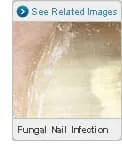Nail Fungus

Anyone can get nail fungus, but infections are more common in people over age 60. For people who have diabetes or a weakened immune system, nail fungus can present serious risks.
What Causes Nail Fungus?
Usually, nail fungus occurs when fungus enters the nail through a small trauma (cut or break) in the nail. Nail fungus is not caused by poor hygiene. Nail fungus can be spread from person to person. It may be hard to determine exactly where or how a fungal infection is acquired. However, a warm, wet place (for example, a locker room) is a good place for a fungus to grow.
What Are the Symptoms of Nail Fungus?
A nail fungus infection can make nails thick and discolored. Uncommonly, you may feel pain in your toes or fingertips.
How Is Nail Fungus Diagnosed?
Your doctor may be able to tell if you have a nail fungus infection by looking carefully at your nails. They may scrape some debris from under a nail and look at it under a microscope or send it to a lab to determine what kind of infection you have.
How Is Nail Fungus Treated?
Treatment for a nail fungus may include topical creams, gels, nail lacquers, or oral medications (antifungal drugs). Rarely, surgery may be required. Although seldom done, removal of the infected nail can be performed to permit direct application of a topical antifungal. Oral drugs, such as terbinafine, can cure about one third of nail fungus infections.
Toenail infections are more difficult to treat than fingernail infections because the toenail grows more slowly. In addition, a damp, warm environment of a shoe or boot can encourage fungal growth.
How Can I Prevent Getting Nail Fungus?
To prevent getting a nail fungus infection:
- Avoid walking barefoot in public areas, such as locker rooms.
- Keep the inside of your shoes dry and change socks frequently (100% cotton socks are recommended).
- Wear shoes that fit properly (shoes with a wide toe area and ones that don't press your toes).
- Use absorbent or antifungal powder.
Ingrown Toenails
Ingrown toenails can occur when the corner or side of the nail grows into the flesh of the toe. In many cases, ingrown nails occur in the big toe. The end result of this common condition is pain, redness, and swelling. Infection can occur in some cases.
What Causes Ingrown Toenails?
Some common causes of ingrown toenail include cutting the nails too short or not straight across, injury to the toenail, and wearing shoes that crowd the toenails.
How Can Ingrown Toenails Be Treated?
In mild cases, ingrown toenails may be treated with a 15-20-minute soak in warm water. Dry cotton can be placed under the corner of the nail. Talk to your doctor if you are experiencing increasing pain, swelling, and drainage of the area. Minor surgery can be performed to remove the part of the nail that is poking into the skin.
How Can Ingrown Toenails Be Prevented?
You can prevent ingrown toenails by:
- Wearing shoes that fit properly
- Keeping toenails at a moderate length and trimming them straight across

